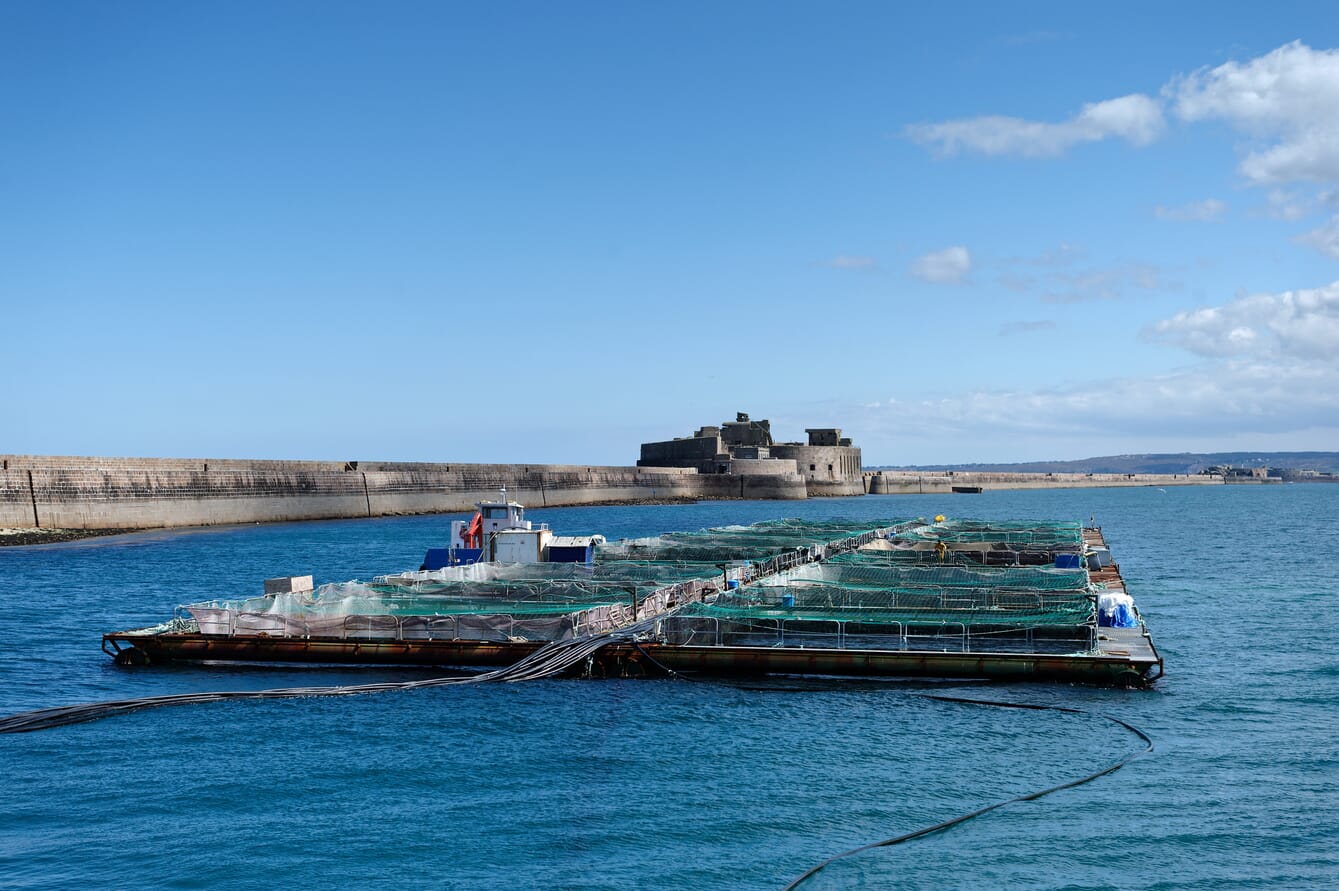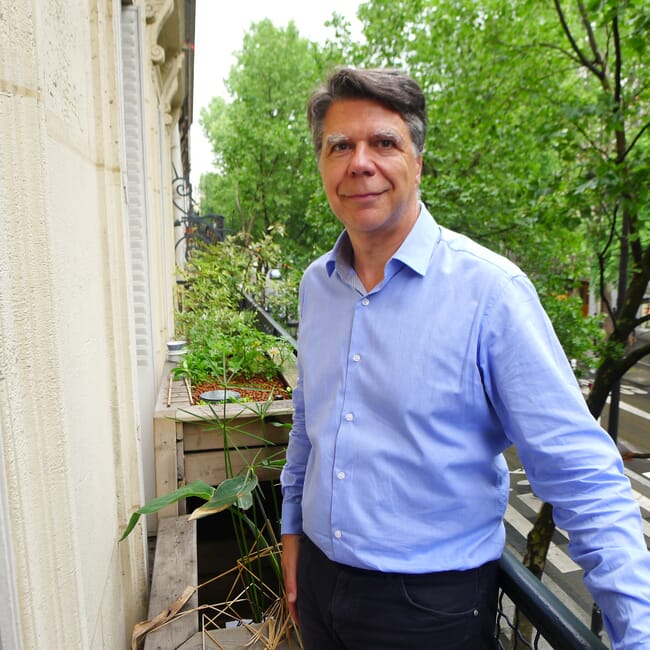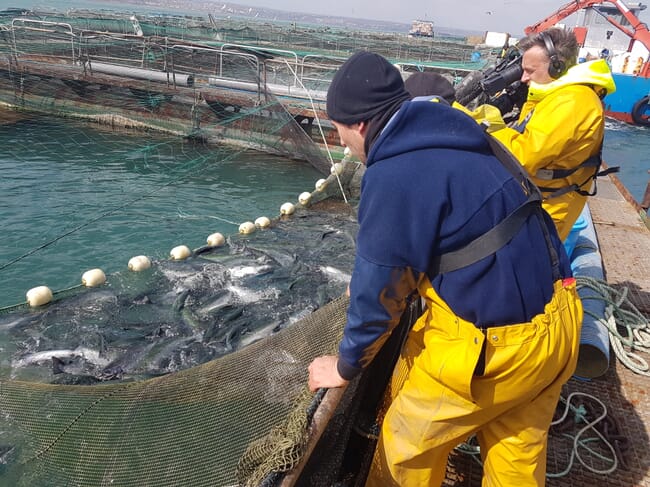
Elevated summer sea temperatures in the English Channel have hugely increased the risk of farming salmon there © Saumon de France
With 24 net pens, Saumon de France, which is based in Cherbourg, is one of the biggest fish farms in the country. Bought in 2014 by Pascal Goumain, now its president, the farm currently produces up to 400 tonnes of salmon and 200 tonnes of rainbow trout annually.
The company recently decided to produce bigger post-smolts in order to reduce the duration of the time the fish spend in the sea and to improve their chances of reaching the 3,000 tonnes of salmon that they are licenced to produce. The decision was made after a major crisis that occurred in the summer of 2022.
“Climate change wiped out the entire stock. The English Channel’s temperature reached 21°C during [one] month, which is 3 to 4°C above salmon’s ideal temperature,” Goumain explains.
The new model involves a multi-phase production approach, in which the salmon spend more time in land-based recirculation facilities, to limit their exposure marine challenges.
“We buy our eggs from companies such as Hendrix Genetics or Benchmark Genetics. They are raised for a year in freshwater in our hatchery in Chartres, which has the capacity to produce 200,000 smolts. Then, the post-smolts are pre-fattened at Saumon d’Isigny in a saltwater RAS from six to eight months until they weigh 1.2kg,” explains Goumain.
“The idea is to put the young fish in our net-cages around November and to harvest them in June, when they reach 4 kg. This way, we avoid production [at sea] during the summer. We would like to control the entire process: from egg, to putting the smolts in the sea and harvesting the adults,” he adds.
In order to do so, Goumain envisions duplicating every part of the cycle: with two hatcheries and two RAS facilities for post-smolts.
“We have a building permit for a second post-smolt, closed-loop system in Cherbourg with a capacity of 200 to 300 tonnes. This way, if there is a problem at any part of the cycle, we [can] avoid a break in production,” he explains.
Facing similar challenges, salmon producers in other parts of Europe are making similar shifts in their production cycles as well, Goumain observes.
“Switching to this new system seems to be taking shape for Norway and Scotland as a good adaptation to climate change," he reflects.
As well as avoiding sanitary risks, reducing open ocean exposure has economical and zootechnical benefits, according to the French producer. However, Goumain believes that small RAS facilities are preferable to large ones.
“In terms of risk management, it is easier to be agile with smaller systems. But there is no such thing as zero risk in aquaculture. Salmon is a relatively recently domesticated species and the techniques used are recent as well, which creates a risky combination," he argues.
Aquaponics and offshore IMTA
The company is also developing other ways to be more resilient to climate change and is part of the Aquaponic Management Project, which was founded by Goumain in 2013. In partnership with Scael, a French agricultural cooperative, the entrepreneur is developing a turnkey aquaponic systems that can be adopted by terrestrial farmers.
“The idea was to create a high-tech and low-cost system. With an investment of €200,000, the farmer can produce 20 tonnes of [rainbow] trout and obtain a complementary revenue of approximately €1,200 per month," explains Goumain.

The two partners aim to equip the first farmers in 2024, installing fish tanks connected to drip systems for growing vegetables, fed by the nutrient-rich water from the tanks.
Looking further ahead, the management group recently obtained plots on an offshore wind farm that is due to be constructed off Cherbourg by 2030.
“We suppose that going further and deeper in the ocean, we should have better environmental conditions for our salmon. First, we would like to test farming in these conditions on a smaller scale, once the offshore wind farm is deployed," explains Goumain.
Moreover, he sees the project as an opportunity to test an integrated multi-trophic aquaculture (IMTA) system, incorporating some form of macroalgae production alongside the salmon. It could provide another option as the company looks to fulfil both its own ambitions and the goals of the government.

Climate change means that they are having to leave the farm fallow during the warmest months of the year © Saumon de France
“The French Ministry of Agriculture set an objective to farm 20,000 tonnes of salmon in France by 2030,” Goumain explains.
And, unsurprisingly, Goumain is determined to capitalise on this support, with plans to raise 6,000 tonnes of salmon between their Cherbourg site and their offshore projects, in addition to 2,000 tonnes of trout, each year.




